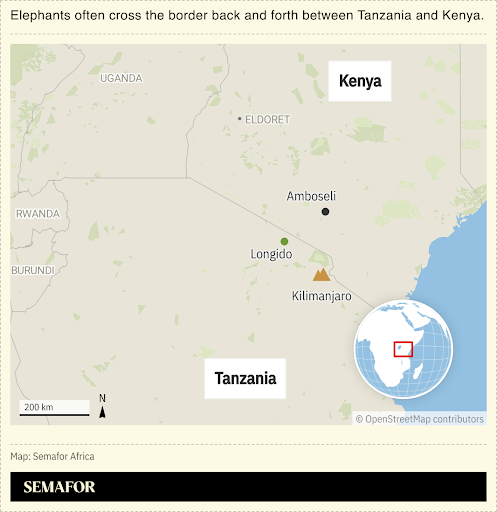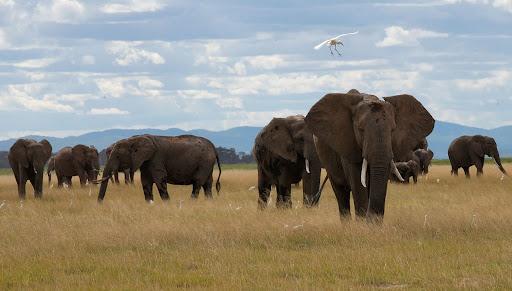The Scoop
NAIROBI — Tanzanian authorities are keen on issuing more hunting permits despite mounting international pressure for the country to ban elephant trophy hunting in the areas surrounding its border with Kenya.
Legal killings of elephants for sport in northern Tanzania have risen over the last year prompting concerns over a dwindling elephant population. This has led to international conservationist groups calling for a ban on the hunting of cross-border elephants.
While elephant hunting is permitted in Tanzania, it has been illegal in Kenya since 1973. Elephants which roam freely between the border areas have traditionally been protected by a gentleman’s agreement between the two countries, but conservationists say this has been ignored in the past year.
At least five elephants were legally targeted and killed by trophy hunters in northern Tanzania over the previous eight months, according to various conservation groups.
But, in an email dated Sept. 18, seen by Semafor Africa, senior Tanzanian officials and researchers doubled down on allowing the hunting of elephants in the area. They cited human-wildlife conflicts and the economic benefits derived from hunting.
“Fourteen villagers in the Longido district and more than 500 acres of crops have been trampled,” it reads in part. “At the same time, trophy hunting brings in huge benefits, funding conservation, paying rangers’ salaries, and building water wells, schools and other critical infrastructure for the communities.”
The letter’s authors, who include representatives of the Tanzania Wildlife Management Authority, Tanzania Hunting Operators Association and the MP for Longido, wrote that Tanzania has “transparent hunting regulation” geared towards protecting both wildlife and the communities living alongside them. It was addressed to the executive editor of Science magazine.
The Washington-based journal in June published a letter by more than 20 elephant biologists and conservationists calling for an end to the hunting of elephants in the borderlands and a harmonized conservation strategy involving Kenya and Tanzania.
*Corrected location of Science magazine
In this article:
Know More

The greater Amboseli-West Kilimanjaro elephant population, spanning both sides of the Kenya-Tanzania border, is made up of approximately 2,000 individual elephants. Around 600 are males, of which 10 are super tuskers — elephants whose tusks weigh over 100 pounds each or touch the ground.
In their letter, Tanzanian officials criticized Science magazine for failing to publish various responses submitted by Tanzanian researchers to the call by conservationists to stop elephant hunting in northern Tanzania. They accused the magazine of discrimination.
“The original letter you published, written predominantly by white authors, none of whom come from Tanzania (many instead from the Global North), only told one side of the story,” they insisted.
In response Science magazine told Semafor Africa that it had received numerous letters in response to a published letter calling for an end to elephant hunting in Tanzania and would not have space to publish all but would be publishing a subset of them.
A spokeswoman for the magazine also pushed back at suggestions of discrimination. “The Science family of journals is very focused on elevating the voices and concerns of authors based in Africa, through efforts including research, commentary, and news.”
Martin’s view
Unlike Kenya, Tanzania’s embrace of hunters has led to the development of a booming trophy hunting industry in the country. In 2022, Tanzania’s trophy hunting industry generated a reported 63.03 billion Tanzanian shillings ($23 million).
Earnings from hunting permits are a significant revenue source for the government. Hunting licenses cost around $60,000 a year, with additional fees for hunting elephants and lions.
Communities seriously affected by human-wildlife conflict could also be more likely to support hunting. However, the killings of elephants by hunters and the supposed economic benefits may not be sustainable in the long term. according to conservationists. They project that the remaining 10 super tuskers in the area could be dead in three years.
Kenya’s wildlife conservation strategy, anchored on tourism as opposed to trophy hunting, would also be affected by a dwindling elephant population in the famed Amboseli region. It is therefore important for authorities in both countries to devise effective joint strategies for conservation in the borderlands.
The View From Zimbabwe
Authorities in Zimbabwe last month decided to cull up to 200 elephants to help feed local communities facing acute hunger after the country’s worst drought in four decades. It would be the country’s first elephant culling since 1988 and take place in Hwange, Mbire, Tsholotsho and Chiredzi districts. Authorities said the culling would help towards decongesting the country’s main parks which can only sustain 55,000 elephants but the country is home to 84,000.
Notable
In April, the president of Botswana threatened to send 20,000 elephants to Germany in a dispute over conservation, reported the BBC.


